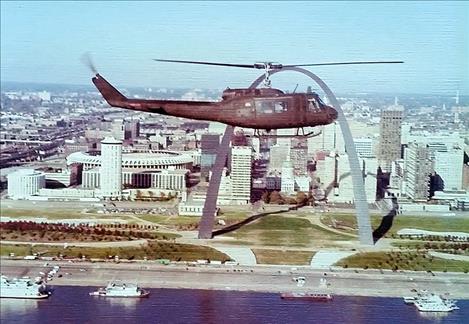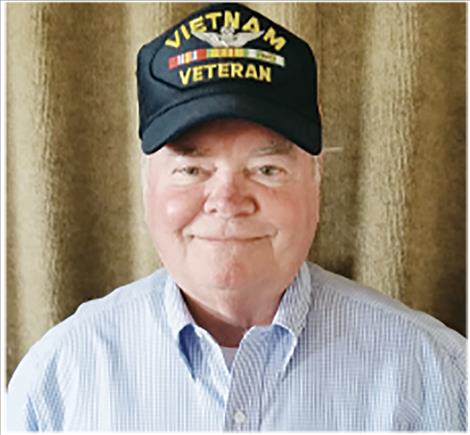Veteran Spotlight
John Moon March 28, 1947 Vietnam - 1st Lieutenant / Army Reserves - Major U.S. Army - 173rd Assault Helicopter Company (the “Robinhoods”)
Hey savvy news reader! Thanks for choosing local.
You are now reading
1 of 3 free articles.
(Editor’s note: This series of articles honors our Veterans of Foreign Wars as they share their military service experiences with the community. This 46th article is about John Moon.)
John Moon’s military career started in 1966 at the University of Dayton in Dayton, Ohio, where two years of ROTC was required. It involved class twice a week, learning military terminology, how to shoot a rifle, practicing marching on the parade field Saturday mornings, etc. If he chose the additional two years, he would be commissioned as second lieutenant and then go on to active duty. Vietnam was the hot spot and if he had to go, he would rather go as an officer. Also, if he agreed to two more years, he would be guaranteed his choice of assignment, and he planned to go to Germany.
Between his junior and senior years, John went to “boot camp” in Hershey, Pennsylvania. While there, a medical exam discovered a heart murmur, probably as a result of childhood rheumatic fever. He was given the choice of being declared 4F (not acceptable for service due to medical or other reasons) and never having to worry about military service again. John had always been active, including running the mile and cross country in high school and playing collegiate soccer for four years. He was a pretty patriotic guy and chose to continue.
When John finished ROTC, he was assigned to the Army Corps of Engineers at Fort Belvoir, Virginia. He didn’t have an engineering background so studying was hard, but he made it through. While completing his studies, some buddies talked him into going to airborne school at Fort Benning, Georgia. John heard how hard airborne school was with all of the running you had to do. He was in good shape, and being a runner to start with, he found it to be a breeze (like an old man shuffle) so no problem. His roommate, who was already a pilot, kept bugging him, “John, John, go to helicopter school with me.”
John said there was no way he would ever go to helicopter school. He said, “The life expectancy of a helicopter pilot in Vietnam is about 37 seconds.
One morning however, John woke up and thought to himself, “You know, I think I’d like to fly helicopters.” So, he called Washington, D.C., and was told, “Sure, we’ll have a slot for you when you’re done with ranger school.” He made five jumps in airborne jump school and then went on to ranger school, which started at Fort Benning. It was really tough. It was so hard that at least 50 percent of the guys dropped out. Going through Army Ranger school is like going through Seal training for the Navy. He spent two weeks at Fort Benning, the next two weeks at Dahlonega, Georgia, and the final two weeks at Eglin AFB, Florida.
Ranger school tries to see if they can break you psychologically. In the first two weeks, besides always being extremely busy, they deprive you of sleep. There were patrols all day and then classes at night. Some of the guys would nod off in class but there were instructors stationed around the room that would wake them up with a switch across the back. The second two weeks were spent climbing in the mountains, repelling down cliffs and out of helicopters and things of that nature. There was plenty of sleep, and they fed you real good. The final two weeks they try to starve you. Boxed “C” rations were equivalent to one meal, so you’d think you would get three a day. No, John got one for the whole day. He remembers on the third day, after getting starved, baloney sandwiches were brought in. “One of the best meals I’ve ever had in my life,” he said. The worst night of his life was having to get from point A to point B through a swamp, through “enemy lines,” trekking through water in the dark for most of the night. But, he made it through.
Then something got screwed up in Washington and John waited at Fort Benning an extra four months for his orders to come through for flight school. During that time, he was an instructor for small river crossings and demolition, blowing up stuff was fun.
Finally, John was off to helicopter school. The first four months he trained in Mineral Wells, Texas, west of Dallas-Fort Worth, in the desert. He learned how to fly a small helicopter. He had a devil of a time and asked his wife where she wanted to go next because he couldn’t master the beast. With a new instructor, he learned he’d been over correcting. Within 10 days, he figured out the controls and made his first solo flight. That’s a super big deal. After about one year of service, while in flight school, he was promoted from second lieutenant to first lieutenant.
The next four months were spent at Fort Rucker, Alabama, which is the home of Army aviation. John learned how to fly the Huey helicopter (UH-1). He finished flight school, had a month off, and then in the latter part of 1971, he went to Vietnam.
John was assigned to Da Nang, which was on the beach with lots of barbed wire to keep out
infiltrators, none ever got through the wire while he was there. John spent time at the base at Marble Mountain, ICor, which was zone one, the farthest north zone. The Viet Cong (North Vietnamese) would shoot mortars from the mountain about once a week. It got to be so routine, the guys would just stay sitting in their Quonset huts playing poker. Some days he flew 14 hours. Since the helicopters could only fly two hours before needing fuel, “hot refueling” was required. That’s where they landed but left the rotors turning while being refueled.
Mission one was to ferry personnel out to field locations, usually mountain tops. Mission two was to insert troops into a LZ (landing zone) to go meet with their counterparts like the Montagnards, and go into combat. John also picked up troops out of PZ’s (pickup zones) and that’s where his aircraft got shot at the most. He was never was hit but his Huey was hit on several occasions. He flew north to the DMZ (demilitarized zone) - what a desolate place that was. So much has been written about drug use in Vietnam. During night duty at the barbed wire barricade he would see little containers, so you know drugs were there, but being with pilots, he didn’t see any drug use.
One time one of their unit’s aircraft was shot down and surrounded by the enemy. The company commander asked if there were any volunteers who wanted to go out and rescue them. With some emotion, John says everybody went with no hesitation whatsoever. They put down a lot of fire power and got them out. Nobody died that day. That was a good day.
By 1972, the Vietnam War was starting to wind down. A letter from Washington offered that if a guy had 180 days served between certain dates, he could be released from Vietnam and from any further active duty. John thought, early out of Vietnam? Early out of his three-year commitment? “Where’s the pen, let me sign!” He got out of the Army in March 1972, got home and his son was born on his birthday, March 28, – that was an exciting week!
John was in the Army Inactive-Reserves and about a year later, he saw an article in the local paper about a helicopter unit close to where he lived. He called and was invited to join. That changed his status from inactive to Active-Reserves. He flew helicopters for about another 10 years, never deployed, always stateside. Looking back, those were the good old days. John was promoted to Major, but then because his unit was over-strength, (too many officers of a certain rank), he had to go back into Inactive-Reserve status. He put in one weekend a month, and a two-week training per year at forts around the country. He earned required points toward full retirement and got his 20-year letter. Over his military career, John flew more than 2,000 hours in a Huey.
John says he had a really good military career but was unable to keep in touch with any of the guys and could not find pictures of himself in uniform. Though Vietnam is a nice country and all, he has no desire to go back. He was very patriotic – but for what? Supposedly he was defending South Vietnam to prevent the domino effect of Communism into the Philippines and other countries, which basically never happened. Unfortunately, over 58,000 people were lost, besides the MIA’s (missing in action), in doing it.
To young people today, John says, without a doubt, “I’d say, go into the military.” You know, you think you’re bullet proof when you’re young. Then when you get older, health-wise, things start breaking down and going bad. “I’ll tell you, one of the best things that ever happened to me was staying in the Reserves to earn full retirement and getting medical care for life.” He wouldn’t have his lifestyle today without it.
Of course, combat is always possible. John thinks U.S. action was necessary to free Kuwait, but going into Iraq? “No I don’t think so. We’re not going to change people’s minds who have been warring for thousands of years.” In his opinion, the National Guard shouldn’t be called up for foreign duty.
John thinks both men and women should serve. So many positions can be filled by women so he doesn’t think women should have to go into combat. If they choose to, then so be it. He remarked that the first two females have graduated out of Ranger school, but he just can’t believe they didn’t bend the rules somewhere. Some think Special Forces is a picnic compared to Ranger school. It’s tough, so tough you think you can eat nails and spit out tacks – you’re invincible.
John says he’d make the same decisions regarding his military career all over again. His cap has the Ranger tab, which is a real honor, parachute wings, and flight wings.
Thank you for your service, John.

















